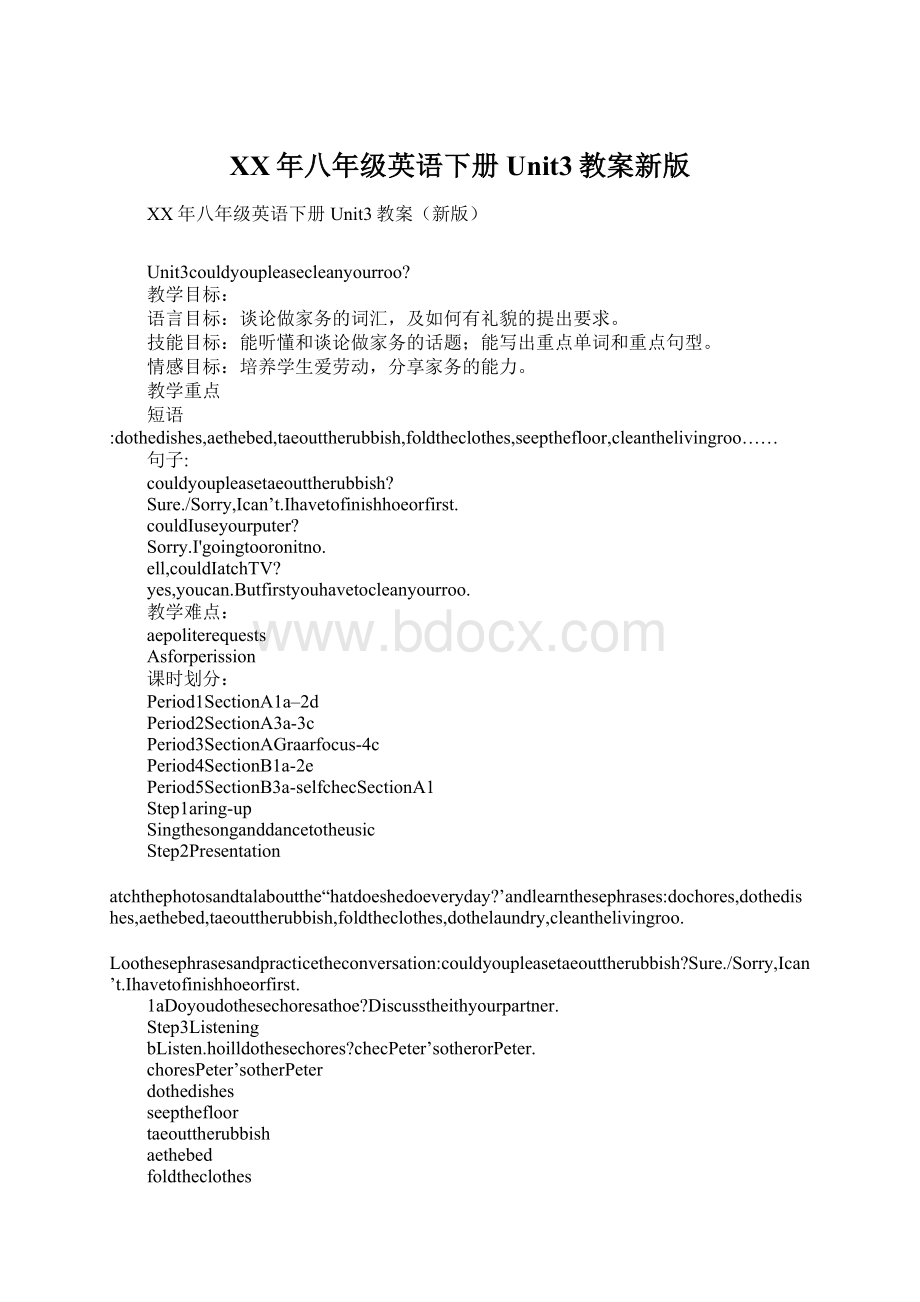XX年八年级英语下册Unit3教案新版.docx
《XX年八年级英语下册Unit3教案新版.docx》由会员分享,可在线阅读,更多相关《XX年八年级英语下册Unit3教案新版.docx(11页珍藏版)》请在冰豆网上搜索。

XX年八年级英语下册Unit3教案新版
XX年八年级英语下册Unit3教案(新版)
Unit3couldyoupleasecleanyourroo?
教学目标:
语言目标:
谈论做家务的词汇,及如何有礼貌的提出要求。
技能目标:
能听懂和谈论做家务的话题;能写出重点单词和重点句型。
情感目标:
培养学生爱劳动,分享家务的能力。
教学重点
短语:
dothedishes,aethebed,taeouttherubbish,foldtheclothes,seepthefloor,cleanthelivingroo……
句子:
couldyoupleasetaeouttherubbish?
Sure./Sorry,Ican’t.Ihavetofinishhoeorfirst.
couldIuseyourputer?
Sorry.I'goingtooronitno.
ell,couldIatchTV?
yes,youcan.Butfirstyouhavetocleanyourroo.
教学难点:
aepoliterequests
Asforperission
课时划分:
Period1SectionA1a–2d
Period2SectionA3a-3c
Period3SectionAGraarfocus-4c
Period4SectionB1a-2e
Period5SectionB3a-selfchecSectionA1
Step1aring-up
Singthesonganddancetotheusic
Step2Presentation
atchthephotosandtalaboutthe“hatdoeshedoeveryday?
’andlearnthesephrases:
dochores,dothedishes,aethebed,taeouttherubbish,foldtheclothes,dothelaundry,cleanthelivingroo.
Loothesephrasesandpracticetheconversation:
couldyoupleasetaeouttherubbish?
Sure./Sorry,Ican’t.Ihavetofinishhoeorfirst.
1aDoyoudothesechoresathoe?
Discusstheithyourpartner.
Step3Listening
bListen.hoilldothesechores?
checPeter’sotherorPeter.
choresPeter’sotherPeter
dothedishes
seepthefloor
taeouttherubbish
aethebed
foldtheclothes
cleanthelivingroo
Step4Practice
caeconversationsaboutthechoresin1a.
aeconversations.
Exaples
A:
couldyouplease...?
B:
yes,sure./Allright./Noproble./certainly.
Sorry,Ican't.Ihavetodo...
Sorry,Ican't.Iadoing...
Step5Listening2a&2b
Peterasshisfatherifhecandofourthings.hatdoeshisfathersay?
chec“yes”or“no”.Listenagain.Dralinestothereasons.
Peterantsto…Peter’sfathersays…Hisfather’sreasons
gooutfordinner.yesNoIhavetodosoeor.
gototheovies.yesNoyouhavetocleanyourroo
stayoutlate.yesNoIneedtoeatbreafast.
getaride.yesNoyouhaveabasetballgae.
Step6Practice
caeconversationsusingtheinforationin2aand2b
A:
couldIuseyourputer?
B:
Sorry.I’goingtooronitno.
A:
ell,couldIatchTV?
B:
yes,youcan.Butfirstyouhavetocleanyourroo?
dRole–playtheconversation
Step7Languagepointsandsuar
helpout动词短语,表示在某人繁忙或
遇到困难时“给予帮助”。
help和out之间还可以加入具体的“人”。
e.g.Hehelpedeoutithytas.
他帮我完成了任务。
Theyhelpedoutiththeclean-up.
他们帮助我们做大扫除。
atleast至少
e.g.eshouldbrushourteethatleastticeaday.
我们每天应该至少刷两次牙。
bebac回
e.g.Ion'tbebactill11:
00.
我11点以前回不来。
anyinuteno
一种常见的口语表达法,相当于“随时;马上;在任何时刻”的意思,表示事情有可能在极短的时间内发生或眼下就要发生。
inute还可以用second,oent,tie等词替换。
e.g.Don'torry,heillehereanyinuteno.
别担心,他会马上来这儿。
Theguestsarearrivinganytienobute’restillnotready.
客人即刻就到,但我们还没有准备好。
e’reexpectingtheanyoentno.
我们期待他们随时到来。
Step8Suar
Nevocabular
dothedishes,seepthefloor,taeoutthetrash,aethebed,foldtheclothes,cleantheroo
---couldyouplease…?
---yes,please./Sorry,Ican’t.
Step8Hoeor1Listalltheainphrasesofdoingchoresthatyouno.
aeaconversationbeteenyouandyourother,usingthesentencepattern“couldyouplease…?
”
SectionA2
Step1Revie
A:
couldyoupleaseaesentencesiththesephrasesinthepasttense?
B:
Sure.Ididsoechores.
taeoutthetrash
dochores
dothedishes
seepthefloor
aedinner
aethebed
foldtheclothes
cleanthelivingroo
helpoutith
atleast
finishdoingsth.
bebacfroshopping
seethisess
otherclean
e.g.1.A:
couldyouplease......?
B:
yes,sure./Allright./Noproble./certainly.
Sorry,Ican't.Ihavetodo...
Sorry,Ican't.Iadoing...
A:
hatindofchoresdidyoudolasteeend?
B:
Ididtheashes.
Step2Reading
aReadthepassageandanserthefolloingquestions.
DidNancydoanyhouseorthatday?
hyasNancy’soangryithNancy?
Didtheysolvetheproble?
Ho?
b.Readthestoryagainandreadthesentencesbelo.Underlinethesentencesfrothereadingthateanthesaething.
Neitherofusdidanyhouseorforaee.
yocaeoverassoonasIsatdoninfrontoftheTV.
you’retired,butI’tired,too.
c.Decidehethertheunderlinedordsinthesentencesareverbsornouns.Thenriteanothersentenceusingtheunderlinedordintheotherfor.
couldyoutaethedogforaal?
couldIatchoneshofirst?
Ican’torallday.
youatchTVallthetie.
“hathappened?
”sheasedinsurprise.
Step3Languagepoints
youatchTVallthetieand...
allthetie一直;向来,一向;时时刻刻;每时每刻
e.g.Idothisallthetie.我一直是这么做的。
Thishappensallthetie.这种情况是时时发生的。
I’justastiredasyouare!
as...as意为“和……一样”,表示同级的比较。
使用时要注意个as为副词,第二个as为连词。
其基本结构为:
as+ad/adv.+as。
e.g.Thisfilisasinterestingasthatone.这部电影和那部电影一样有趣。
yourpenritesassoothlyasine.你的钢笔书写起来和我的一样流畅。
as…as的否定形式为“notas/so+ad/adv.+as”。
e.g.Hedidn’tactasellasyou.他表现得不如你好。
Foroneee,shedidnotdoanyhouseor,andneitherdidI.
neither用作副词,作“也不”解释,放在句首,表示前面否定的内容也适用于另一个人或物,句子须采用部分倒装。
此时也可用nor替换neither使用。
例如:
—Idon’tliethisdress.我不喜欢这件连衣裙。
—Neither/NordoI.我也不喜欢。
注意:
neither之后的主语要置于助动词或系动词之后。
neither用作代词,表示“两者都不,双方均不”。
例如:
Heanseredneitheroftheletters.他两封信都没回。
—hichoneouldyoulie?
你喜欢哪一个?
—Neither.两个都不喜欢。
also,too,either,neither的用法
一、also是比较正式的用语,语气较庄重。
它通常放在句中,位于行为动词之前,连系动词之后;如有助动词或情态动词,一般放在助动词或情态动词之后。
例如:
Peteralsohastobrothers.彼得也有两个兄弟。
Iaalsoastudent.我也是一名学生。
rs.Greencanalsosingthesonginchinese.格林夫人也能用汉语唱这首歌。
二、too是普通用词,多用于口语,语气较随便。
一般用在肯定句中,放在句末。
例如:
I’inRo1,too.我也在排。
注意:
also和too一般都用于肯定句,很少用于否定句。
三、either表示“也”时,一般只用于否定句,且置于句末。
例如:
Idon’tnohi.Todoesn’tnohi,either.
我不认识他,汤姆也不认识他。
Ifyoudon’tgothere,heon’tgothere,either.
如果你不去那儿,他也不会去那儿。
注意:
either本身没有否定的意义。
所以多与not连用。
四、neither表示“两个都不”,它作主语时,谓语动词常用单数。
例如:
Neitherofyoucandoit.你们两个都不能做这件事。
Step4Suar
Nevocabular
lastonth,eover
taethedogforaal,atchonesho
allthetie,thenextday,neitherdidI
TheinuteIsatdoninfrontoftheTV,yocaeover.
Foroneee,shedidnotdoanyhouseor,andneitherdidI.
I’justastiredasyouare!
Step5Hoeor1.Listalltheainphrasesofdoingchoresthatyouno.
aeaconversationbeteenyouandyourother,usingthesentencepattern“couldyouplease…?
couldI…?
”
SectionA3
Step1Revision
根据所学内容,写出下列短语。
foldone’sclothes,dothedishes,useone’sputer,taeouttherubbish
aethebed,seepthefloor,stayoutlate,beangryithsb.,taesb.foraalcleanthelivingroo,oron,eover,dothehouseor,getaride
Step2Presentation
阅读下列句子,观察问句的用法及回答。
couldIgooutfordinnerith
friends?
Sure,thatshouldbeo.
couldegetsoethingtodrinafterthe
ovie?
No,youcan’t.youhavea
basetballgaetoorro.
couldyoupleasetaethedogforaal?
o,butIanttoatchonesho
first.
couldyoupleasetaeouttherubbish?
yes,sure.
Step3Graar
couldyou+V-原形?
表示委婉地提出请求
couldyoupleasecleanyourroo?
yes,sure./ofcourse./certainly./Allright.
couldyoupleasedothedishes?
Sorry,Ican’t.Ihavetodoyhoeor.
在表示请求帮助或请求允许的疑问句中,常用could代替can,以表示礼貌,委婉或不确定的语气,而can则不具备这些语气。
这种情况下不能把could看作can的过去式。
以上两句中用could是为了表示礼貌的请求。
表示请求帮助或请求允许时,除了can,could之外,还可以用ay,句子的表达方式也各有不同,可以用不同的方式来表示同一个概念。
例:
①could/can/ayIuseyourcarforaday?
②IonderifIcoulduseyourcarforaday?
对于①、②句所作允答可以各种各样,如同意可以说yes或Sure或certainly,还可说yes,please.或ofcourse..或Goahead,please.或That’so/allright;如果不同意,可以说I’sorryyoucan’t.或I’reallysorry,butIhavetouseittoday.要避免说No,youcan’t.这样显得很不礼貌。
否定回答通常用委婉语气。
③DoyouindifIuseyourcarforaday?
对于句③所作回答可以说Neverind./Notatall.表“不介意”。
不能用yes./Sure./ofcourse./certainly.等。
无论肯定还是否定应答中,要避免使用could,要用can或ay。
因为应答须用确定的语气。
而could在表请求的问句中是为了表示礼貌或委婉语气,用在应答中则成了不确定语气,与情理不符。
所以应答中不说yes,youcould.或No,youcouldn’t.而要说yes,youcan.或Sorry./No,youcan’t.
—couldIpleaseuseyourputer?
—Sorry,I’goingtooronitno.
—ell,couldIatchTV?
—yes,youcan.
couldI/youplease…?
表示一种有礼貌的请求或提议,其后连接原形动词,比canyou/I…?
语气更委婉。
类似句型有:
ouldyoulie+sth./todosth.?
ayI+dosth.?
Shalle+dosth.?
ouldyouind+sth./doingsth.?
hat/Hoabout+sth./doingsth.?
肯定回答有Sure./ofcourse./certainly./o./Great./ell./Goodidea./Iagree.等。
否定回答有Sorry…/No,youcan’t.等。
Step4Practice
aeupdialoguesusingthesentencesinGraarFocusithyourpartner.
A:
couldyoupleasetaethedogforaal?
B:
o,butIanttoatchoneshofirst.
ariteRforrequestsandPforperission.Thenatcheachoneiththecorrectresponse.
___couldIhangoutithyfriendsaftertheovies?
出去玩
___couldyoupleasepassethesalt?
___couldIborrothatboo?
___couldyouhelpedothedishes?
___couldyoulendesoeoney?
a.yes,hereyouare.
b.H.Houchdoyouneed?
c.yes,sure.Noproble.Ifinishedreadingitlastnight.
d.yes,butdon’tebactoolate.
e.No,Ican’t.IcutyfingerandI'tryingnottogetitet.
Note:
borro和lend
borro和lend都有“借”的意思,但它们的含义和用法有所不同。
★borro表示“借入”,即把本来不属于自己的东西借来暂时使用,常与介词fro连用。
如:
youcanborroaboofrothelibrary.
★lend表示“借出”,即把属于自己的东西借给别人暂时使用,常与介词to连用,也可以跟双宾语。
如:
He’sgoingtolendhisbietoTo.
youustn’tlendothersypen.
bFillintheblansintheconversation.
A:
Ihateto____chores.
B:
ell,Ihatesoechorestoo,butIlieotherchores.
A:
Really?
Great!
_____Iasyouto____eithsoechoresthen?
B:
hatdoyouneedhelpith?
A:
______youplease_____yclothesfore?
B:
Idon’tanttodothat!
It’sboring!
A:
o.Then______you______dothedishesfore?
B:
Sure,noproble.But_____egototheoviesafterthat?
A:
Sure.I’llfinishyhoeorhileyouhelpeiththedishes.Thenecangototheovies.
Step5Discussion
Ifearehavingacapingtrip,hatshouldedobeforethetrip?
Step6Hoeorritealettertoyourfriendtoashi/hertotaecareofyourhousehenyouareon
vacation.
SectionB1
Step1Revie
单项选择。
--couldyoupleasetaecareofydog?
--______.I’toobusy.
A.yes,youcan
B.Sure
c.Sorry,Ican’t
--couldyouplease____hisbed?
--certainly!
A.aesB.aingc.ae
--couldIuseyourcar?
--______.
A.Sure,youcan
B.Sorry,youcan
c.Sure,Ican
couldyouhelp_____?
A.aingthebed
B.aethebed
c.adethebed
Step2Discussion
Q1:
Doyouhelpyourparentsdothechoresathoe?
Q2:
Doyouasyourparents’perissionfor?
Q3:
Doyourparentsasyoutodosoethingsforthe?
Givesoepicturesandanserthefolloingquestions.
hatdoyourparentsasyoutodo?
hatdoyouasyourparents’perissionfor?
Step3
Finish1a.hatdoteenagersastheirparents’perissionfor?
hatdoparentsastheirteenagerstodo?
riteparentsorteenagersnexttoeachphrase.
buysoedrinsandsnacs
borrosoeone
cleanyourroo
inviteyfriendstoapart
gotothestore
useyourcDplayer
taeouttherubbish
aeyourbed
Step4.
Finish1b.Usethe